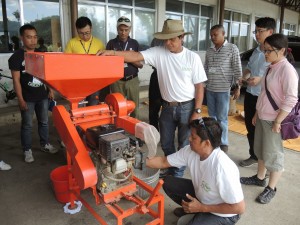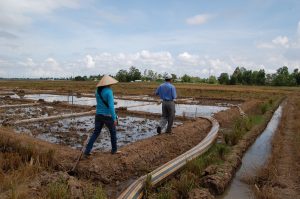Cambodia’s Ministry of Agriculture, Forestry and Fisheries released a selection of hybrid rice varieties higher tolerance to water shortages and other stresses associated with climate change compared to conventional cultivars. The hybrid rice varities also produce significantly better yields.
The wide adoption of hybrid rice could lead to significant improvement in yields to meet Cambodia’s food security goals and improve rural livelihoods.
Read the full story at The Japan News
More on hybrid rice:
The Hybrid Rice Development Consortium (HRDC)
HRDC promotes innovation and access to new germplasm and information on hybrid rice technology. It is a membership-based organization that helps other organizations collaborate in the research and production of hybrid rice varieties.
Across the rice-producing world, there are well-recognized “yield gaps”—the difference between how much rice a system can potentially produce and the actual amount a farmer produces. Hybrid rice varieties are a key technology that can help close that gap, improving yield and profitability.
Hybrid rice get highest yields for rice farmers in Bohol, Philippines
A rice farmer from Paraiso, Mabini town in Bohol, Estarlita Vallecera. got for the first time the highest yield from its hybrid rice farm when she harvested an average of eight metric tons per hectare during his actual harvest last October 16 and the Department of Agriculture (DA) here is expecting more Bohol rice farmers to have the same harvests.
This prompted Mabini mayor Juanito Jayoma to inform DA-Central Visayas to personally see the actual harvest that was considered as a great harvest since it is the first time a farmer in the municipality got this highest yield.
Hybrid rice: Corteva slowly making inroads into Bihar, Jharkhand; trains 90K woman farmers
Global agriculture firm Corteva Agriscience is slowly making inroads to push its hybrid paddy seeds and other products in Bihar and Jharkhand, where it has trained about 90,000 women pravaktas or village leaders on growing hybrids along with agronomic practices and post-transplantation care.
These rural women were growing inbred rice, a self-pollinated home-grown rice, in a traditional way. Now, they are trained to grow hybrid seeds even by using the direct seeded rice technique. Now, they have become ambassadors of early adopters of the new technology and advocating the same in their villages to have a multiplier effect, thereby creating demand and market for hybrid seeds and crop protection products.








